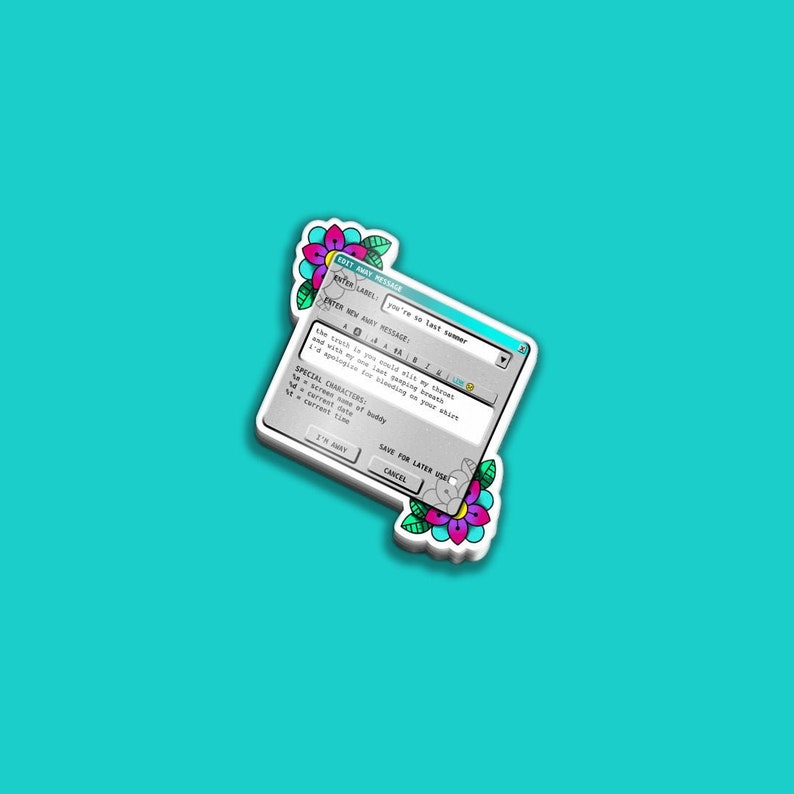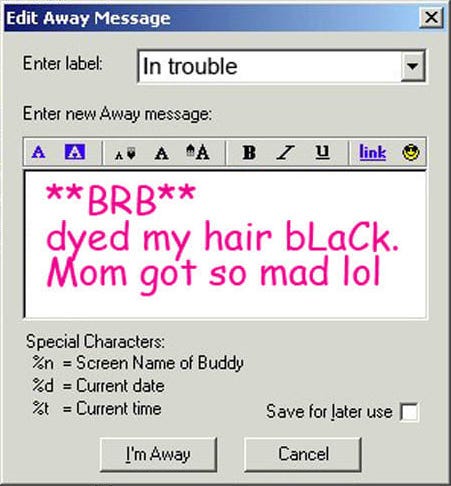

Even the names of these features - Focus, Schedule Send - are phrases born of a work-obsessed culture. These are squishy orange cones that we all plow through, like 15-year-olds in driver’s ed. More than just cute pictures, these digital icons are a lingua franca for the digital age. This, it turns out, is an invitation to be disturbed anyway. You can write “Writing, please DND,” because you’re once again behind on a deadline. You can give fair warning that you’re Out of Office or slap a “sick” emoji on your profile. The always-on workplace chat app Slack offers “Update Your Status,” the closest thing we have to Away Messages today. ” Yes, you can “Mute Notifications” on WhatsApp.
#Aim away messages android
On iPhone and iPad, there’s “Do Not Disturb” and “Focus” mode, while Android OS supports “Do Not Disturb” as well as “Schedule Send,” which, as a Google spokesperson put it, “is great when you’re texting across time zones, such as when you want to send an early morning Happy Birthday to your friend in London. Oh fine, you’re going to insist I mention some of the messaging guardrails tech companies have rolled out in recent years. Nothing like this exists in our modern messaging apps. It was also a boundary: An Away Message not only popped up as a response after someone IM’d you, it was wholly visible to that person before they IM’d you.
#Aim away messages update
An Away Message was a text box full of possibilities, a mini-MySpace profile or a Facebook status update years before either existed.
#Aim away messages code
The bits of code that constructed Maginot Lines around our availability. But this is about Away Messages themselves.

This nostalgia is layered in abstraction I probably miss the newness of the internet of the 1990s, and I also miss just being… away. Never mind that my Away Message is aimed at you. Or, here’s a song lyric that signals I am so over you. I’ve left you with an emo quote that demonstrates how deep I am. I’m in class / at the game / my dad needs to use the comp. So you threw up an Away Message: I’m not here.

A digital door creaked open, and me and millions of others scrambled to our seats to see who had just signed on, who was down to chat. It propelled me into a universe of limitless pixels, endless distractions, and a penchant for bland screen names (my only embellishment was my basketball jersey number, tacked on to my initials). Very online, and unaware at the time that the portal would disappear behind you once you crossed through, that you would never again live a wholly offline life.ĪIM, which launched 25 years ago this month, represented that moment for me. Your parents got the compact disc in the mail, you plugged your clear plastic corded phone into a modem connected to your Gateway 2000, and you were off. You didn’t need to be a computer nerd to ride the AIM train. But AIM was the beginning of somethinga gateway to real-time, all-time internet communication for the normies. Talkomatic, Compuserve’s CB Simulator, and Internet Relay Chat (IRC) all preceded it. In the beginning, there was AOL Instant Messenger.


 0 kommentar(er)
0 kommentar(er)
